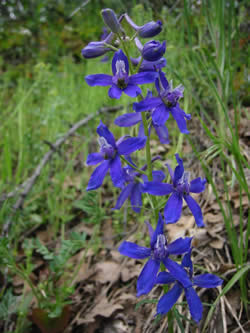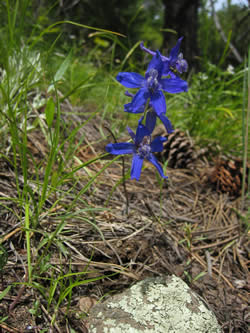Plant of the Week
 Delphinium nuttallianum range map. USDA PLANTS Database.
Delphinium nuttallianum range map. USDA PLANTS Database.
 These blue to purple flowers have traditionally been used in ceremonies, and as a dye. Photo by Andrew Kratz.
These blue to purple flowers have traditionally been used in ceremonies, and as a dye. Photo by Andrew Kratz.
 Nuttall’s larkspur occurs in a wide variety of habitats, including open ponderosa pine forests. Photo by Andrew Kratz.
Nuttall’s larkspur occurs in a wide variety of habitats, including open ponderosa pine forests. Photo by Andrew Kratz.
Nuttall’s larkspur (Delphinium nuttallianum)
By Andrew Kratz
Nuttall’s larkspur is one of more than 60 native species of larkspur in the United States. It is among the more wide-ranging species, occurring from British Columbia and Alberta south to California, Arizona and New Mexico, and as far east as South Dakota and Nebraska. It grows in sagebrush desert, grassy shrublands, open conifer forests (especially ponderosa pine), at the edges of meadows, and along streams. It prefers well-drained gravelly soils, in moist but not wet sites. Soils can vary from acid to neutral or basic. It can be found from about 1,000 to 10,000 feet in elevation, and needs a sunny location.
The flowers appear in spring and early summer. They vary from light blue to deep purple, and may have white upper petals. The flowers are notable for the long “spur” projecting to the rear of the flower, which adds to the visual interest for many wildflower enthusiasts. The flowers are widely spaced on the upper end of stems from about six to eighteen inches tall. The number of flowers varies from just a few to about a dozen on a single plant. The leaves are deeply lobed, and most are located at the base of the plant, with a few smaller leaves borne along the flowering stem. The plant is a perennial, with fleshy roots.
Nuttall’s larkspur is a member of a complex of several species displaying many variations in characteristics, which makes identification difficult and confusing. Adding to the confusion is the fact that members of the complex can form hybrids with each other.
All parts of the plant are toxic, and it has been involved in poisoning cattle on western rangelands. The primary toxic compounds are alkaloids (methyllycaconitine and nudicauline). The concentrations of these alkaloids vary from location to location, and vary with the age of the plant. Young plants tend to be the most poisonous. A parasiticide can be made from the leaves, but is for external use only due to its toxicity.
A blue dye can be made from the flowers, which has also been used as ink. Traditionally, native peoples have used the flowers of this larkspur for coloring arrows and other items, or for various ceremonies.

